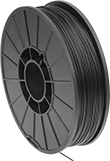Flexible TPU 3D Printer Filaments

Stretchy, soft, and sturdy, these filaments make durable parts that resist breakage despite repeated use. Stronger than ABS and PLA filaments, they create long-lasting parts, such as seals, sleeves, and gaskets, as well as components that take on high-impact forces, such as springs and snap-fit parts. These filaments don't require a heated printer bed, and they won't shrink or warp when cooling. Use them with a fused filament fabrication (FFF) 3D printer. In general, these flexible filaments require a slow feed rate so they don't jam. The softer your filament, the slower your feed rate will need to be. Store them in a sealed container with a desiccant, or use a dehumidifying cabinet, since ambient humidity will cause the plastic to degrade and weaken.
Static-dissipative filaments make parts that protect equipment from electrostatic shocks by diverting electrostatic discharges in a controlled way. Use them to create tool handles, tote trays, enclosures, and other parts that are used near sensitive electronics. They meet ANSI/ESD and IEC standards for manufacturing, packaging, transporting, and storing items that can be damaged by electrostatic shocks.
You can adjust the surface resistivity in static dissipative and conductive filaments by changing the temperature of your printer's extruder. As the extruder’s temperature increases, the printed part’s resistivity will decrease.
For the most flexible parts, use durometer 85A or 80A filaments. They're more flexible than other TPU filaments. For a quick print without sacrificing flexibility, choose durometer 95A filaments. They print much faster than other TPU filaments. Durometer 74D filaments make tough, durable parts that act similar to a tire tread—flexing repeatedly without cracking.
Tensile strength is the best measure of a filament's overall strength. Similar to the stress applied on a rope during a game of tug-of-war, it's the amount of pulling force a material can handle before breaking. A higher rating means a stronger filament. A tensile strength of 5,000 psi and above is considered good; 12,000 psi and above is excellent.
Maximum exposure temperature is the point at which a printed part will begin to deform. Above this temperature, your printed parts will start to lose structural integrity.
Spool | |||||||||||||
|---|---|---|---|---|---|---|---|---|---|---|---|---|---|
| Dia., mm | Printing Temp. | For Printer Bed Temp. | Tensile Strength | Surface Resistivity | Max. Exposure Temp. | Specifications Met | For Min. Nozzle Opening Dia., mm | Dia., mm | Dp., mm | Wt., g | Color | Each | |
Static-Dissipative TPU Plastic—Durometer 80A (Soft) | |||||||||||||
| 1.75 | 230° to 250° C 446° to 482° F | 50° to 80° C 122° to 176° F | 3,100 psi | 106-108 ohms/sq. | Not Rated | ANSI/ESD S541, IEC 61340 | 0.4 | 200 | 60 | 750 | Opaque Black | 00000000 | 0000000 |
| 2.85 | 230° to 250° C 446° to 482° F | 50° to 80° C 122° to 176° F | 3,100 psi | 106-108 ohms/sq. | Not Rated | ANSI/ESD S541, IEC 61340 | 0.4 | 200 | 60 | 750 | Opaque Black | 00000000 | 000000 |
Static-Dissipative TPU Plastic—Durometer 95A (Medium Soft) | |||||||||||||
| 1.75 | 230° to 250° C 446° to 482° F | 50° to 80° C 122° to 176° F | 4,900 psi | 106-108 ohms/sq. | Not Rated | ANSI/ESD S541, IEC 61340 | 0.4 | 200 | 60 | 750 | Opaque Black | 00000000 | 000000 |
| 2.85 | 230° to 250° C 446° to 482° F | 50° to 80° C 122° to 176° F | 4,900 psi | 106-108 ohms/sq. | Not Rated | ANSI/ESD S541, IEC 61340 | 0.4 | 200 | 60 | 750 | Opaque Black | 00000000 | 000000 |
Static-Dissipative TPU Plastic—Durometer 74D (Medium) | |||||||||||||
| 1.75 | 230° to 250° C 446° to 482° F | 50° to 80° C 122° to 176° F | 4,700 psi | 106-108 ohms/sq. | 160° C 320° F | ANSI/ESD S541, IEC 61340 | 0.25 | 200 | 60 | 750 | Opaque Black | 00000000 | 000000 |
| 2.85 | 230° to 250° C 446° to 482° F | 50° to 80° C 122° to 176° F | 4,700 psi | 106-108 ohms/sq. | 160° C 320° F | ANSI/ESD S541, IEC 61340 | 0.25 | 200 | 60 | 750 | Opaque Black | 00000000 | 000000 |

























